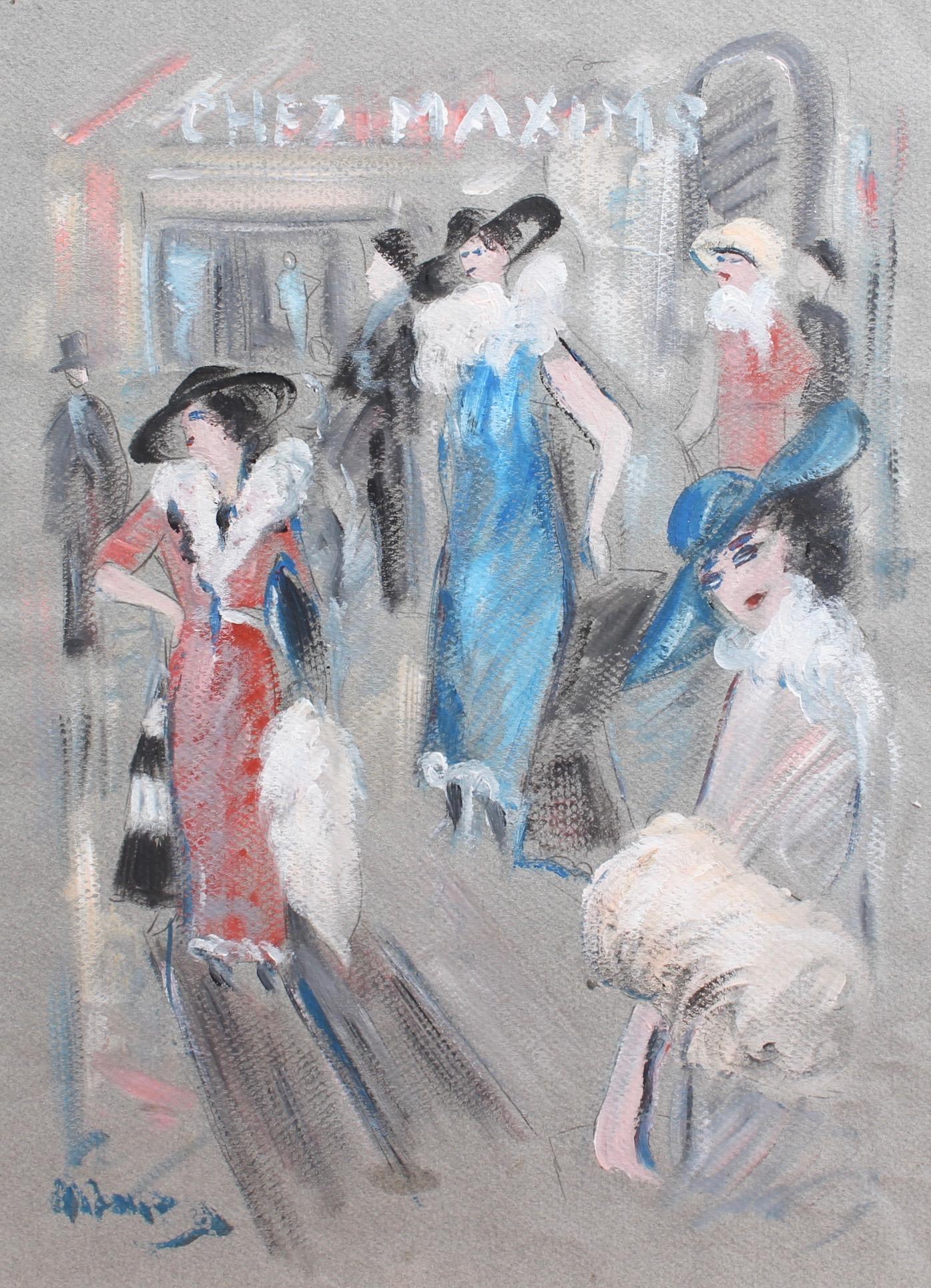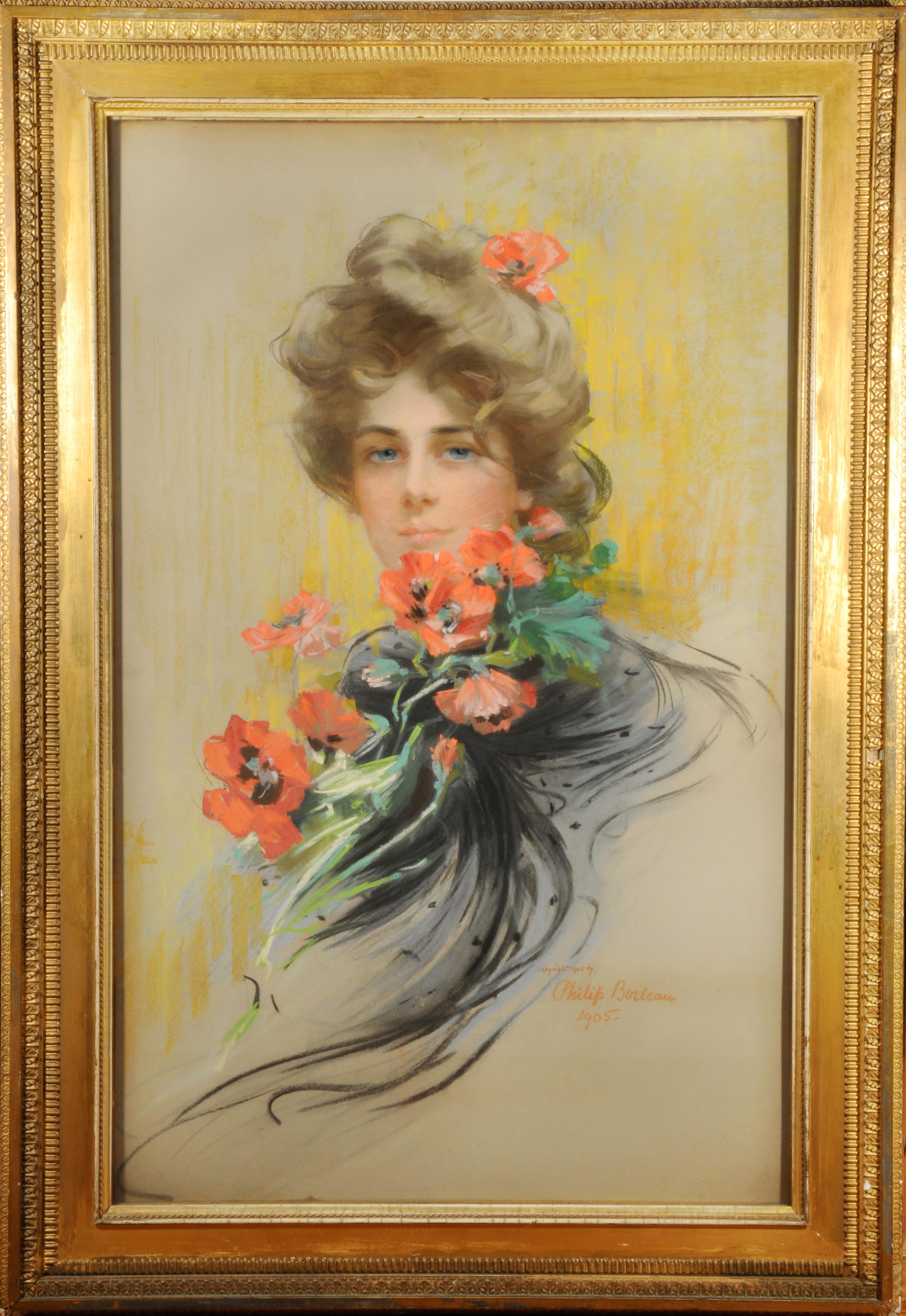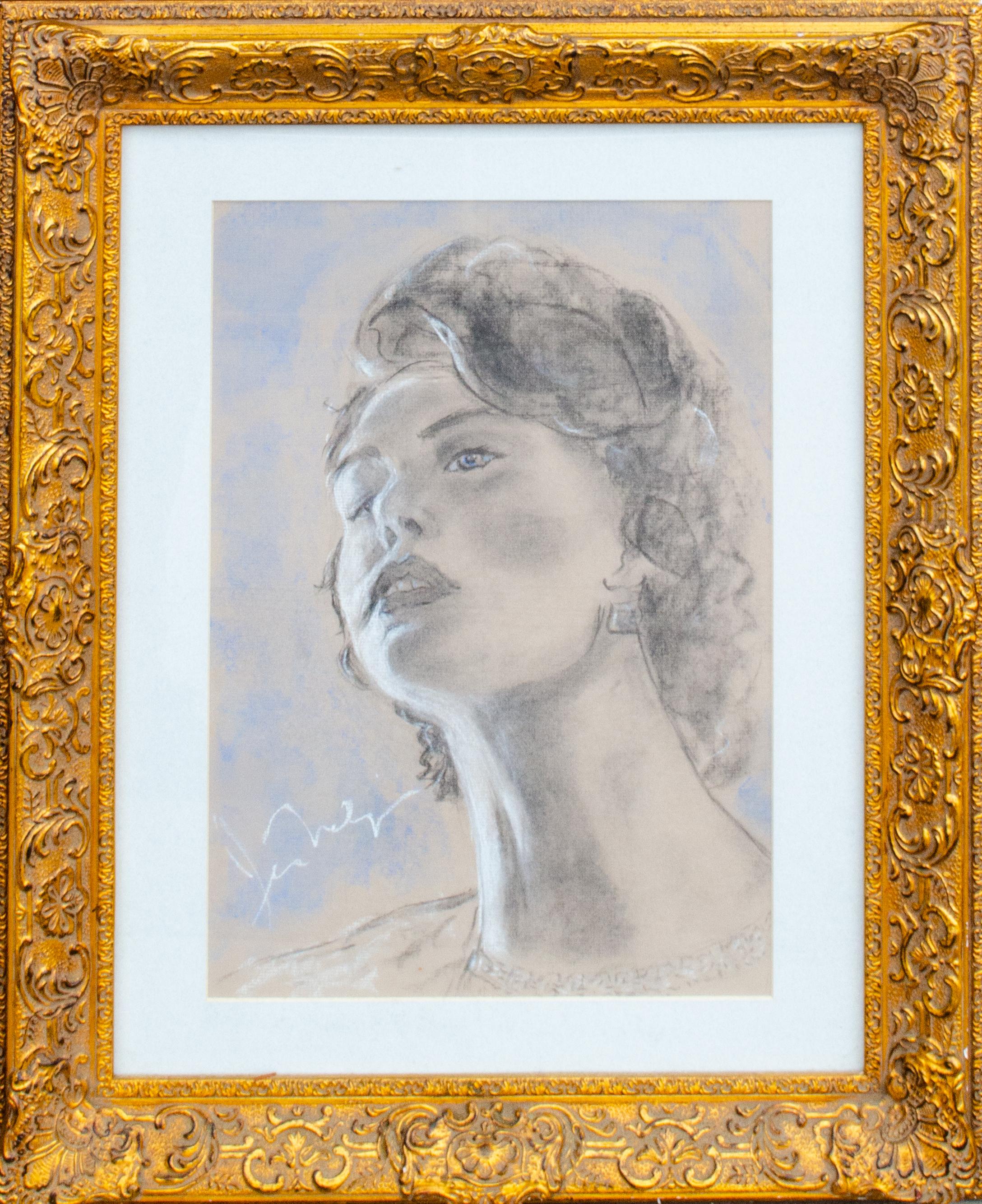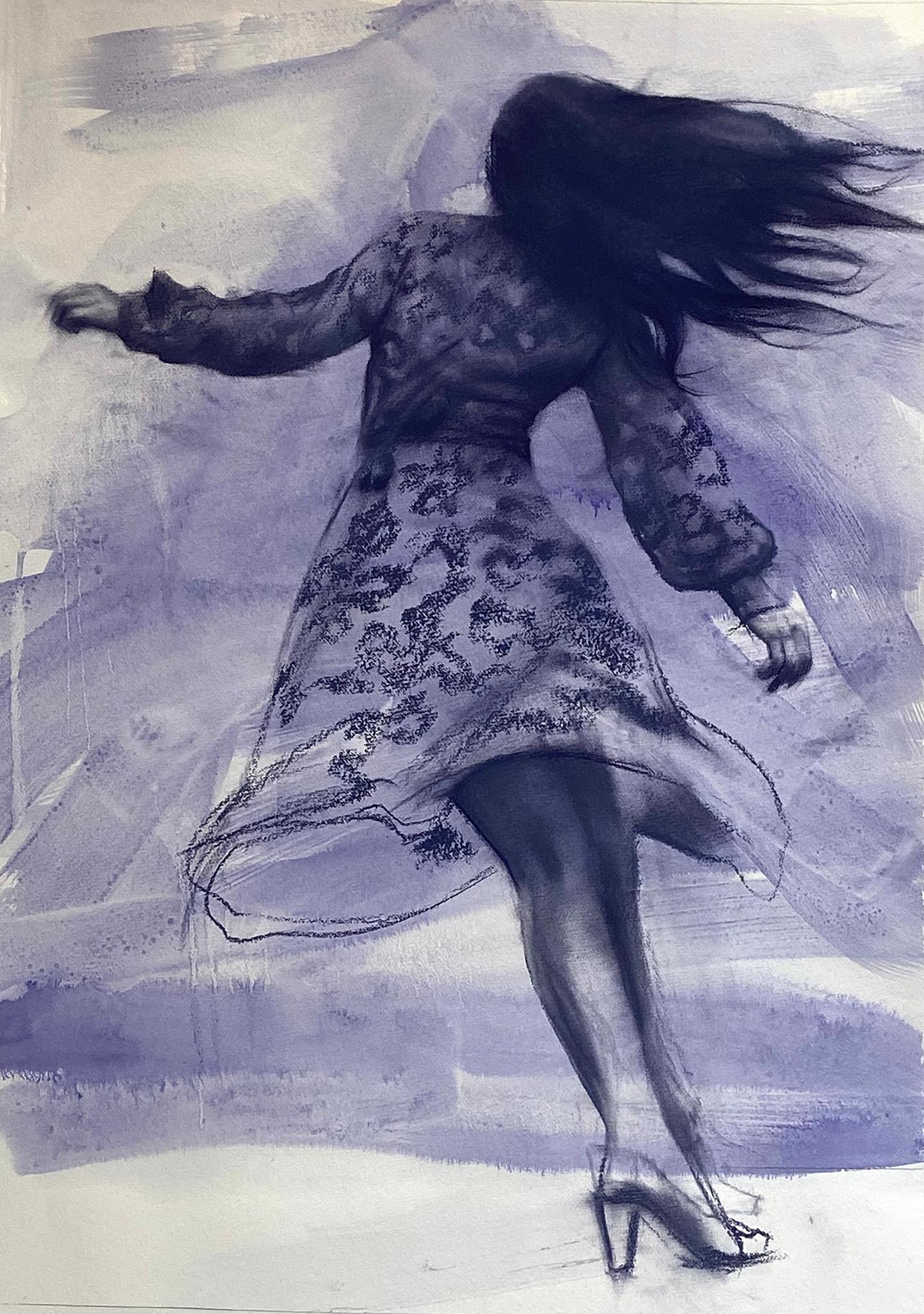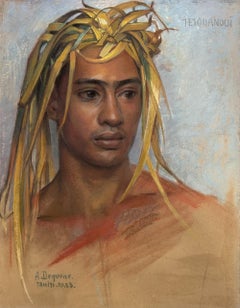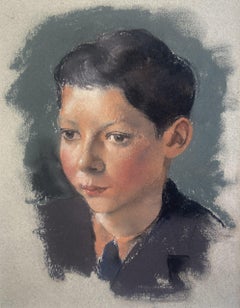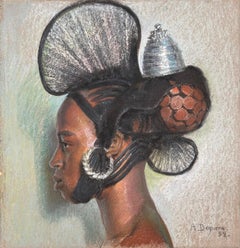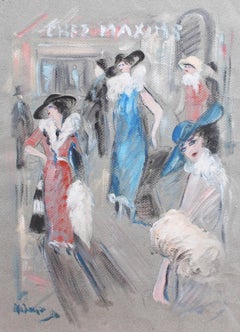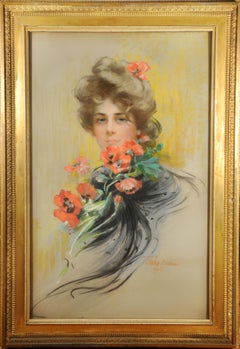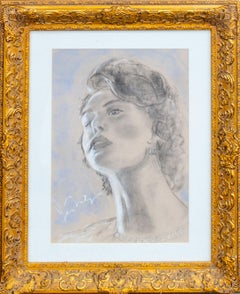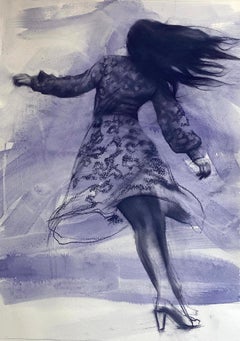Items Similar to Imperial Beauty, British School 20th Century Pastel Portrait
Want more images or videos?
Request additional images or videos from the seller
1 of 8
20th Century British SchoolImperial Beauty, British School 20th Century Pastel Portrait
About the Item
Pastel on paper on canvas, initialled lower left "ND"
Image size: 13 ¾ x 22 ½ inches (35 x 57 cm)
Gilt frame
This fine Art Nouveau picture executed around 1900, depicts an auburn haired girl with a halo behind her and surrounded by Fritillaria Imperialis. It was the Pre-Raphaelites who caught the public's attention to redheads. They were fascinated by them, producing vast quantities of images featuring flowing, curly, red hair dominating work from the era. This carried on into the Art Noveau period.
From the 1880s until the First World War, Europe witnessed the development of Art Nouveau. Taking inspiration from the unruly aspects of the natural world, Art Nouveau influenced art and architecture especially in the applied arts, graphic work, and illustration.
- Creator:20th Century British School
- Dimensions:Height: 13.75 in (34.93 cm)Width: 22.5 in (57.15 cm)
- More Editions & Sizes:1 of 1Price: $3,988
- Medium:
- Movement & Style:
- Period:
- Condition:
- Gallery Location:London, GB
- Reference Number:1stDibs: LU52412632132
About the Seller
5.0
Vetted Professional Seller
Every seller passes strict standards for authenticity and reliability
Established in 2007
1stDibs seller since 2014
80 sales on 1stDibs
Typical response time: 1 hour
- ShippingRetrieving quote...Shipping from: London, United Kingdom
- Return Policy
Authenticity Guarantee
In the unlikely event there’s an issue with an item’s authenticity, contact us within 1 year for a full refund. DetailsMoney-Back Guarantee
If your item is not as described, is damaged in transit, or does not arrive, contact us within 7 days for a full refund. Details24-Hour Cancellation
You have a 24-hour grace period in which to reconsider your purchase, with no questions asked.Vetted Professional Sellers
Our world-class sellers must adhere to strict standards for service and quality, maintaining the integrity of our listings.Price-Match Guarantee
If you find that a seller listed the same item for a lower price elsewhere, we’ll match it.Trusted Global Delivery
Our best-in-class carrier network provides specialized shipping options worldwide, including custom delivery.More From This Seller
View AllTetouanoui Man
Located in London, GB
Tetouanoui Man
Albert Charles Dequene
Pastel on paper, signed and dated 1933 lower left, titled upper right
Image size: 23 x 18 inches (58.4 x 45.7 cm)
Hand made ebonised and gilded ...
Category
20th Century French School Drawings and Watercolor Paintings
Materials
Paper, Pastel
Translucent Boy, 20th Century British Artist, Pastel Portrait
By Peter Gardner
Located in London, GB
Pastel on paper
Image size: 6 x 7 inches (15.25 x 17.75 cm)
Mounted
Peter Gardner
Peter Gardner was born in London in 1921. He studied at the Hammersmith School of Art between 193...
Category
Early 20th Century Modern Portrait Drawings and Watercolors
Materials
Paper, Pastel
Portrait of a Boy, Pastel Drawing, 20th Century English
By William Dring
Located in London, GB
Pastel and graphite on paper
Image size: 11 x 8 1/2 inches (28 x 21.5 cm)
Mounted
William Dring
Dring was born with the forenames Dennis William, but was known colloquially as John. He was the brother of the artist James Dring. He married the painter Grace Elizabeth Rothwell...
Category
Mid-20th Century Portrait Drawings and Watercolors
Materials
Paper, Pastel, Graphite
Fouta Djallon woman with crest headdress
Located in London, GB
Albert Charles Dequene
Fouta Djallon woman with crest headdress
Pastel on paper, signed lower right & dated '32'
Image size: 19 3/4 x 18 inches (50 x 46 cm)
Hand made ebonised and gi...
Category
20th Century Portrait Drawings and Watercolors
Materials
Paper, Pastel
Price Upon Request
Portrait of a Lady - Late 18th Century European Pastel
Located in London, GB
European School
Late 18th Century
Portrait of a Lady
Pastel on paper, mounted on canvas
Image size: 28 x 23 inches
Contemporary style frame
Provenance:
Ernst Museum Auction
This pastel portrait of a lady dates from the late eighteenth century. She is pictured in a white muslin dress...
Category
Late 18th Century Portrait Drawings and Watercolors
Materials
Pastel, Laid Paper
Portrait of a Young Man Original Charcoal and Pastel French 18th Century
Located in London, GB
French School
18th Century
Portrait of a Young Man
Charcoal and pastel on paper
Image size: 11 x 7 inches
Contemporary gilt frame
Category
18th Century Rococo Portrait Drawings and Watercolors
Materials
Paper, Charcoal, Pastel
You May Also Like
Chez Maxim's
By André Meurice
Located in London, GB
'Chez Maxim's', pastel and gouache on fine art paper, by André Meurice (circa 1950s - 60s). The artist depicts the glamorous clientele at the entryway to...
Category
Mid-20th Century Art Nouveau Figurative Drawings and Watercolors
Materials
Pastel, Gouache
$577 Sale Price
30% Off
Woman With Red Poppies
By Philip Boileau
Located in New York, NY
Woman With Red Poppies, 1905, by Philip Boileau (1863-1917)
Pastel on paper
35 ½ × 22 ¾ inches unframed (90.17 x 57.785 cm)
Signed, dated, and inscribed...
Category
Early 20th Century Art Nouveau Portrait Drawings and Watercolors
Materials
Pastel
Price Upon Request
Portrait of a 1920s Woman by Mystery American Artist
Located in New York, NY
Charcoal and pastel on paper
Sight: 16 1/2 x 11 1/2 in.
Framed: 24 1/2 x 20 1/4 x 1 2/3 in.
Signed lower right
Inscribed verso
Category
Early 20th Century American Impressionist Portrait Drawings and Watercolors
Materials
Paper, Pastel, Charcoal
Revolutions, dynamic surreal purple drawing on paper of pretty girl dancing
By Patsy McArthur
Located in Dallas, TX
"Revolutions" is a dynamic and unique ink and pastel drawing on paper by Patsy McArthur showing a fashionable female figure dancing. The energy and movement makes it fun and whimsica...
Category
2010s Realist Figurative Drawings and Watercolors
Materials
Pastel, Archival Paper, Ink
$2,320 Sale Price
20% Off
Hula Study, energetic realistic charcoal drawing on paper, girl and hula hoop
By Patsy McArthur
Located in Dallas, TX
"Hula Study" is an energetic and unique charcoal on paper by Patsy McArthur showing a female figure dancing with a hula hoop. It is created using charcoal and pastel on pale pink Mur...
Category
2010s Realist Figurative Drawings and Watercolors
Materials
Charcoal, Archival Paper, Pastel, Handmade Paper
Rare Modernist Hungarian Rabbi Pastel Drawing Gouache Painting Judaica Art Deco
By Hugó Scheiber
Located in Surfside, FL
Rabbi in the synagogue at prayer wearing tallit and tefillin.
Hugó Scheiber (born 29 September 1873 in Budapest – died there 7 March 1950) was a Hungarian modernist painter.
Hugo Scheiber was brought from Budapest to Vienna at the age of eight where his father worked as a sign painter for the Prater Theater. At fifteen, he returned with his family to Budapest and began working during the day to help support them and attending painting classes at the School of Design in the evening, where Henrik Papp was one of his teachers. He completed his studies in 1900. His work was at first in a post-Impressionistic style but from 1910 onward showed his increasing interest in German Expressionism and Futurism. This made it of little interest to the conservative Hungarian art establishment.
However, in 1915 he met the great Italian avant-gardist Filippo Tommaso Marinetti and the two painters became close friends. Marinetti invited him to join the Futurist Movement. The uniquely modernist style that he developed was, however, closer to German Expressionism than to Futurism and eventually drifted toward an international art deco manner similar to Erté's. In 1919, he and his friend Béla Kádar held an exhibition at the Hevesy Salon in Vienna. It was a great success and at last caused the Budapest Art Museum to acquire some of Scheiber's drawings. Encouraged, Scheiber came back to live in Vienna in 1920.
A turning point in Scheiber's career came a year later, when Herwarth Walden, founder of Germany's leading avant-garde periodical, Der Sturm, and of the Sturm Gallery in Berlin, became interested in Scheiber's work. Scheiber moved to Berlin in 1922, and his paintings soon appeared regularly in Walden's magazine and elsewhere. Exhibitions of his work followed in London, Rome, La Paz, and New York.
Scheiber's move to Germany coincided with a significant exodus of Hungarian artists to Berlin, including Laszlo Moholy-Nagy and Sandor Bortnyik. There had been a major split in ideology among the Hungarian avant-garde. The Constructivist and leader of the Hungarian avantgarde, Lajos Kassák (painted by Hugó Scheiber in 1930) believed that art should relate to all the needs of contemporary humankind. Thus he refused to compromise the purity of his style to reflect the demands of either the ruling class or socialists and communists. The other camp believed that an artist should be a figurehead for social and political change.
The fall out and factions that resulted from this politicisation resulted in most of the Hungarian avant gardists leaving Vienna for Berlin. Hungarian émigrés made up one of the largest minority groups in the German capital and the influx of their painters had a significant effect on Hungarian and international art. Another turning point of Scheiber's career came in 1926, with the New York exhibition of the Société Anonyme, organized by Katherine Dreier. Scheiber and other important avant garde artists from more than twenty-three countries were represented. In 1933, Scheiber was invited by Marinetti to participate in the great meeting of the Futurists held in Rome in late April 1933, Mostra Nazionale d’Arte Futurista where he was received with great enthusiasm. Gradually, the Hungarian artists began to return home, particularly with the rise of Nazism in Germany. Kádar went back from Berlin in about 1932 and Scheiber followed in 1934.
He was then at the peak of his powers and had a special flair in depicting café and cabaret life in vivid colors, sturdily abstracted forms and spontaneous brush strokes. Scheiber depicted cosmopolitan modern life using stylized shapes and expressive colors. His preferred subjects were cabaret and street scenes, jazz musicians, flappers, and a series of self-portraits (usually with a cigar). his principal media being gouache and oil. He was a member of the prestigious New Society of Artists (KUT—Képzőművészek Új Társasága)and seems to have weathered Hungary's post–World War II transition to state-communism without difficulty. He continued to be well regarded, eventually even receiving the posthumous honor of having one of his images used for a Russian Soviet postage stamp (see image above). Hugó Scheiber died in Budapest in 1950.
Paintings by Hugó Scheiber form part of permanent museum collections in Budapest (Hungarian National Museum), Pecs (Jannus Pannonius Museum), Vienna, New York, Bern and elsewhere. His work has also been shown in many important exhibitions, including:
"The Nell Walden Collection," Kunsthaus Zürich (1945)
"Collection of the Société Anonyme," Yale University Art Gallery, New Haven, Connecticut (1950)
"Hugó Scheiber: A Commemorative Exhibition," Hungarian National Museum, Budapest (1964)
"Ungarische Avantgarde," Galleria del Levante, Munich (1971)
"Paris-Berlin 1900-1930," Centre Georges Pompidou, Paris (1978)
"L’Art en Hongrie, 1905-1920," Musée d’Art et l’Industrie, Saint-Etienne (1980)
"Ungarische Avantgarde in der Weimarer Republik," Marburg (1986)
"Modernizmus," Eresz & Maklary Gallery, Budapest (2006)
"Hugó Scheiber & Béla Kádár," Galerie le Minotaure, Paris and Tel Aviv (2007)
Hugó Scheiber's paintings continue to be regularly sold at Sotheby's, Christie's, Gillen's Arts (London), Papillon Gallery (Los Angeles) and other auction houses.
He was included in the exhibition The Art Of Modern Hungary 1931 and other exhibitions along with Vilmos Novak Aba, Count Julius Batthyany, Pal Bor, Bela Buky, Denes Csanky, Istvan Csok, Bela Czobel, Peter Di Gabor, Bela Ivanyi Grunwald, Baron Ferenc Hatvany, Lipot Herman, Odon Marffy, C. Pal Molnar...
Category
Early 20th Century Modern Figurative Paintings
Materials
Paper, Charcoal, Pastel, Watercolor, Gouache
Recently Viewed
View AllMore Ways To Browse
European School Painting
British School Painting
20th Century British Art
British Portrait Of
20th Century British Painting
1900 School
School Girl
European School Portrait
British School Portrait
Pastel 1900
Antique Pastel Portrait
British Art Nouveau
Imperial Portrait
Pre Raphaelite
Pastel Portrait Girl
Antique Art Nouveau Picture Frames
Paintings Pre 1900
Art Antique Pre 1900 Paintings
